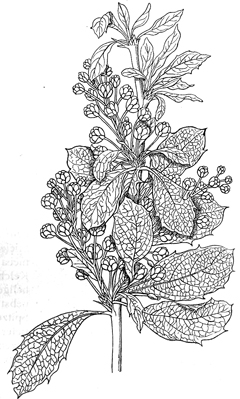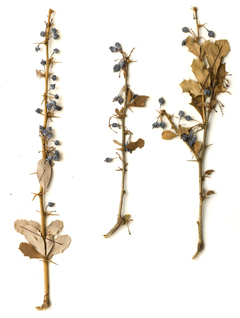 |
|
http://commons.wikimedia.org/wiki/File:Berberis_asiatica_drawing.jpg |
 |
| The Royal Botanic Garden Edinburgh |
Translate this page:
Summary
Physical Characteristics

 Berberis asiatica is an evergreen Shrub growing to 3.5 m (11ft 6in) at a medium rate.
Berberis asiatica is an evergreen Shrub growing to 3.5 m (11ft 6in) at a medium rate.
See above for USDA hardiness. It is hardy to UK zone 8 and is not frost tender. It is in leaf all year, in flower in May. The species is hermaphrodite (has both male and female organs) and is pollinated by Insects. The plant is self-fertile.
It is noted for attracting wildlife.
Suitable for: light (sandy), medium (loamy) and heavy (clay) soils and can grow in heavy clay and nutritionally poor soils. Suitable pH: mildly acid, neutral and basic (mildly alkaline) soils. It can grow in full shade (deep woodland) semi-shade (light woodland) or no shade. It prefers dry or moist soil.
UK Hardiness Map
US Hardiness Map
Synonyms
Plant Habitats
Woodland Garden Dappled Shade; Shady Edge; not Deep Shade;
Edible Uses
Edible Parts: Fruit
Edible Uses:
Fruit - raw or dried and used like raisins[2, 3, 51, 105, 158, 183]. This species is said to make the best Indian raisins[183]. Fully ripe fruits are fairly juicy with a pleasantly acid flavour, though there are rather a lot of seeds[K]. The fruit is abundantly produced in Britain[2]. The fruit is about 8mm long[200].
References More on Edible Uses
Medicinal Uses
Plants For A Future can not take any responsibility for any adverse effects from the use of plants. Always seek advice from a professional before using a plant medicinally.
Antibacterial Cancer Dysentery Laxative Odontalgic Ophthalmic Tonic
The roots are used in treating ulcers, urethral discharges, ophthalmia, jaundice, fevers etc[240]. The roots contain 2.1% berberine, the stems 1.3%[240]. The bark and wood are crushed in Nepal then boiled in water, strained and the liquid evaporated until a viscous mass is obtained. This is antibacterial, laxative and tonic[272]. It is taken internally to treat fevers and is used externally to treat conjuctivitis and other inflammations of the eyes[272]. Tender leaf buds are chewed and held against affected teeth for 15 minutes to treat dental caries[272]. The fruit is cooling and laxative[272]. Berberine, universally present in rhizomes of Berberis species, has marked antibacterial effects. Since it is not appreciably absorbed by the body, it is used orally in the treatment of various enteric infections, especially bacterial dysentery[218]. It should not be used with Glycyrrhiza species (Liquorice) because this nullifies the effects of the berberine[218]. Berberine has also shown antitumour activity[218].
References More on Medicinal Uses
The Bookshop: Edible Plant Books
Our Latest books on Perennial Plants For Food Forests and Permaculture Gardens in paperback or digital formats.

Edible Tropical Plants
Food Forest Plants for Hotter Conditions: 250+ Plants For Tropical Food Forests & Permaculture Gardens.
More

Edible Temperate Plants
Plants for Your Food Forest: 500 Plants for Temperate Food Forests & Permaculture Gardens.
More

More Books
PFAF have eight books available in paperback and digital formats. Browse the shop for more information.
Shop Now
Other Uses
Dye
Agroforestry uses?: Barberry can be used as a hedge, as it provides dense foliage that offers shelter for wildlife. Additionally, its deep roots can help with soil stabilization.
A yellow dye is obtained from the roots and stems[272]. The spiny branches are used to make fencing around fields in Nepal[272]. 1. Nectary - Flowers rich in nectar and pollen:
Yes – Barberry flowers are small but rich in nectar and pollen, attracting bees and other pollinators.
2. Wildlife - Food (Fruit, Seeds, Leaf litter, Shelter, Nesting, Roosting):
Yes – Barberry produces edible berries that are a food source for birds and other wildlife. The dense, thorny branches provide good shelter and protection for nesting and roosting birds.
3. Invertebrate Shelter (Overwintering sites, Leaf litter, Groundcover):
Yes – Barberry shrubs' dense structure and leaf litter can offer overwintering sites and shelter for invertebrates.
4. Pest Confuser (Smell):
No – Barberry is not known for emitting a smell that confuses pests.
Special Uses
Food Forest
References More on Other Uses
Cultivation details
Prefers a warm moist loamy soil and light shade but it is by no means fastidious, succeeding in thin, dry and shallow soils[11, 200]. Grows well in heavy clay soils. Plants are often found growing in dense shade in the wild[67]. Plants are generally very hardy and fruit abundantly in Britain[2]. They grow very well in Cornwall[11, 59]. In colder areas of the country they are apt to be cut to the ground in severe winters, though they resprout well from the base[1, 67]. Hybridizes freely with other members of this genus[1]. This species is often offered under the names of B. chitria or B. glaucocarpa[200]. Plants can be pruned back quite severely, they resprout well from the base[200]. Barberry is a moderately fast-growing plant, often reaching maturity in 3 to 5 years, depending on the species and growing conditions. The berries are typically harvested in late summer to early autumn, when they are ripe.
Barberry generally flowers in spring, depending on the species and local climate.
References Carbon Farming Information and Carbon Sequestration Information
Temperature Converter
Type a value in the Celsius field to convert the value to Fahrenheit:
Fahrenheit:
The PFAF Bookshop
Plants For A Future have a number of books available in paperback and digital form. Book titles include Edible Plants, Edible Perennials, Edible Trees,Edible Shrubs, Woodland Gardening, and Temperate Food Forest Plants. Our new book is Food Forest Plants For Hotter Conditions (Tropical and Sub-Tropical).
Shop Now
Plant Propagation
Seed - best sown as soon as it is ripe in a cold frame, when it should germinate in late winter or early spring[78]. Seed from over-ripe fruit will take longer to germinate[78], whilst stored seed may require cold stratification and should be sown in a cold frame as early in the year as possible[80]. The seedlings are subject to damping off, so should be kept well ventilated[113]. When the seedlings are large enough to handle, prick them out into individual pots and grow them on in a cold frame. If growth is sufficient, it can be possible to plant them out into their permanent positions in the autumn, but generally it is best to leave them in the cold frame for the winter and plant them out in late spring or early summer of the following year. Cuttings of half-ripe wood, July/August in a frame. Cuttings of mature wood of the current season's growth, preferably with a heel, October/November in a frame[78].
Other Names
If available other names are mentioned here
Aul chotra, Barberry, Choto, Chutro, Kilmora, Kimor, Kingora,
Native Range
TROPICAL ASIA: Bhutan, India, Sikkim, Bihar, Himachal Pradesh, Madhya Pradesh, Uttar Pradesh, West Bengal, Arunachal Pradesh, Nepal,
Weed Potential
Right plant wrong place. We are currently updating this section.
Please note that a plant may be invasive in one area but may not in your area so it's worth checking.
Conservation Status
IUCN Red List of Threatened Plants Status :

Growth: S = slow M = medium F = fast. Soil: L = light (sandy) M = medium H = heavy (clay). pH: A = acid N = neutral B = basic (alkaline). Shade: F = full shade S = semi-shade N = no shade. Moisture: D = dry M = Moist We = wet Wa = water.
Now available:
Food Forest Plants for Mediterranean Conditions
350+ Perennial Plants For Mediterranean and Drier Food Forests and Permaculture Gardens.
[Paperback and eBook]
This is the third in Plants For A Future's series of plant guides for food forests tailored to
specific climate zones. Following volumes on temperate and tropical ecosystems, this book focuses
on species suited to Mediterranean conditions—regions with hot, dry summers and cool, wet winters,
often facing the added challenge of climate change.
Read More
Expert comment
Author
Roxb. ex DC.
Botanical References
1167200
Links / References
For a list of references used on this page please go here
Readers comment
| Add a comment |
|
If you have important information about this plant that may help other users please add a comment or link below. Only comments or links that are felt to be directly relevant to a plant will be included. If you think a comment/link or information contained on this page is inaccurate or misleading we would welcome your feedback at [email protected]. If you have questions about a plant please use the Forum on this website as we do not have the resources to answer questions ourselves.
* Please note: the comments by website users are not necessarily those held by PFAF and may give misleading or inaccurate information.
To leave a comment please Register or login here All comments need to be approved so will not appear immediately.
|
Subject : Berberis asiatica
|
|
|
|